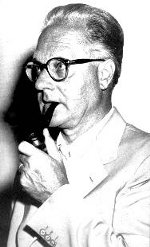Director's Corner
20 November 2008
 Barry Barish |
The legacy of Edoardo Amaldi
Edoardo Amaldi was one of the giants who shaped our field. He was celebrated last month at the University of Rome on the 100th anniversary of his birth in the inspiring meeting “The Legacy of Edoardo Amaldi in Science and Society.” I was honoured to be invited to speak about international collaboration in physics, an area where Amaldi led the way, especially for his role in the creation and development of CERN. In fact, his impact on physics and society was far broader than his contributions to particle physics alone: they also include his scientific contributions and leadership in nuclear physics, gravitational wave research and astrophysics. Moreover, he worked to protect human rights, and more generally was committed to promoting peace and to controlling the proliferation of nuclear weapons.
Edoardo Amaldi was born in Italy in 1908 to a famous mathematician father. He became interested in studying physics while he was a high school student and eventually became a student under Orso Mario Corbino, working under the guidance of the young Enrico Fermi. Fermi had already obtained a chair in theoretical physics and went on to win the Nobel Prize in 1938. Amaldi became part of Fermi's exceptional group at the University of Rome that included Emilio Segrè, Franco Rasetti, Ettore Majorana and Bruno Pontecorvo. Amaldi's most important work before World War II involved neutron scattering off matter. Throughout his career, he made significant and most impressive contributions to a wide range of fields of physics.
Fermi's group dispersed to the US and elsewhere because of the imminent threat of WWII and prosecution of Jews by the fascists. Although Amaldi visited the US and seriously considered emigrating, he made the difficult decision to stay in Rome: he did not want to take a position that could go to someone who was forced to leave Europe. He also wanted to return to his young family in Rome. This left Amaldi essentially alone to carry on with the high standards of Italian physics. He did a remarkable job, and after the war he played a key role in rebuilding the proud tradition of Italian physics.
Amaldi became a very strong proponent of scientific and technical collaboration between European countries for rebuilding Europe, leading naturally on to his role in the creation of CERN. He then served as CERN's first Secretary-General from 1952 to 1954, and later played a leading role in the study, preparation and early stages of the new programme of accelerators centered on the construction of the Intersecting Storage Rings (ISR) and the 300-GeV proton synchrotron (SPS).
There were many well-known speakers at the celebration for Amaldi's 100th birthday, who had either worked or studied with Amaldi, or who were strongly influenced by him in science or regarding societal issues. I was there to represent his pioneering efforts to internationalise physics research.
Francesco Colegera, who served as Secretary-General of the Pugwash Conferences on Science and World Affairs from 1989 to 1997, spoke on the history and the future of efforts to stop nuclear proliferation. Colgera is a theoretical physicist and mathematician who was inspired by Amaldi to work on the threat to society of nuclear weapons. Together with Pugwash and Joseph Rotblat, he accepted the 1995 Nobel Peace Prize for their work.
The scientific programme also included a talk by Adalberto Giazotto, former spokesman of the Virgo gravitational wave experiment near Pisa, Italy. I am very partial to this field, since my primary research involvement before joining the ILC GDE was in this field and I am still involved. Gravitational waves became Amaldi's principle research area at the end of his career, and he played a very important role in developing resonant bar detectors for gravitational waves. No detections of gravitational waves were made by his experiment, or any other experiment for that matter, they still remain to be detected! Nevertheless, his contributions were so significant that those of us in the field named the principle conference in the field after Amaldi in the late 1990s.
There were many personal remembrances of Edoardo Amaldi during the meeting, including talks by his son Ugo Amaldi, a well-known particle physicist at CERN. Ugo gave a technical talk on his present interests in medical radiation physics and the advancements in techniques for treatment of tumors. Also, more personal discussions by the family members were offered (in Italian).
I want to end today's column by bringing up a serious counterpoint to this celebration of Amaldi that was more than a celebration of an exceptional scientist and human being, but also of the grand tradition of Italian physics. One must wonder whether this tradition will continue, due to recent actions announced by the Italian government to redirect funds for education and research towards fiscal investments in banks and other financial institutions.
A recent article in Nature summarises the government decree, including deep budget reductions for education and research, replacing only one in five permanent positions upon retirement and drastically cutting temporary research staff. At the time of the Amaldi meeting, the buildings of the University were occupied by student protesters and we heard impromptu pleas from the protesting students and researchers. They emphasised to us the need and importance of strong international support for their cause. I urge all of you to realise the seriousness of this threat to Italian universities and science and to offer whatever support you can to our Italian colleagues.
-- Barry Barish


